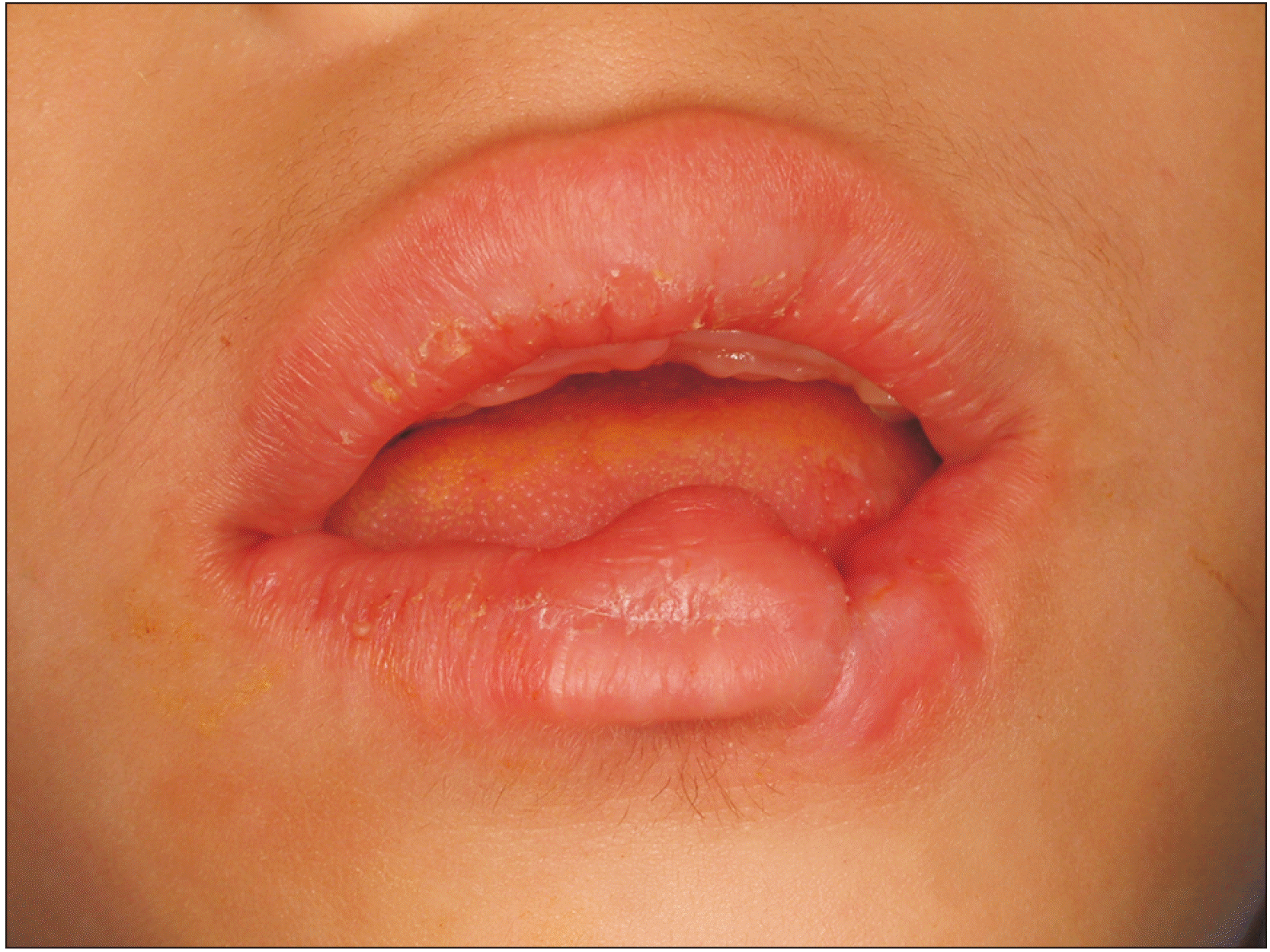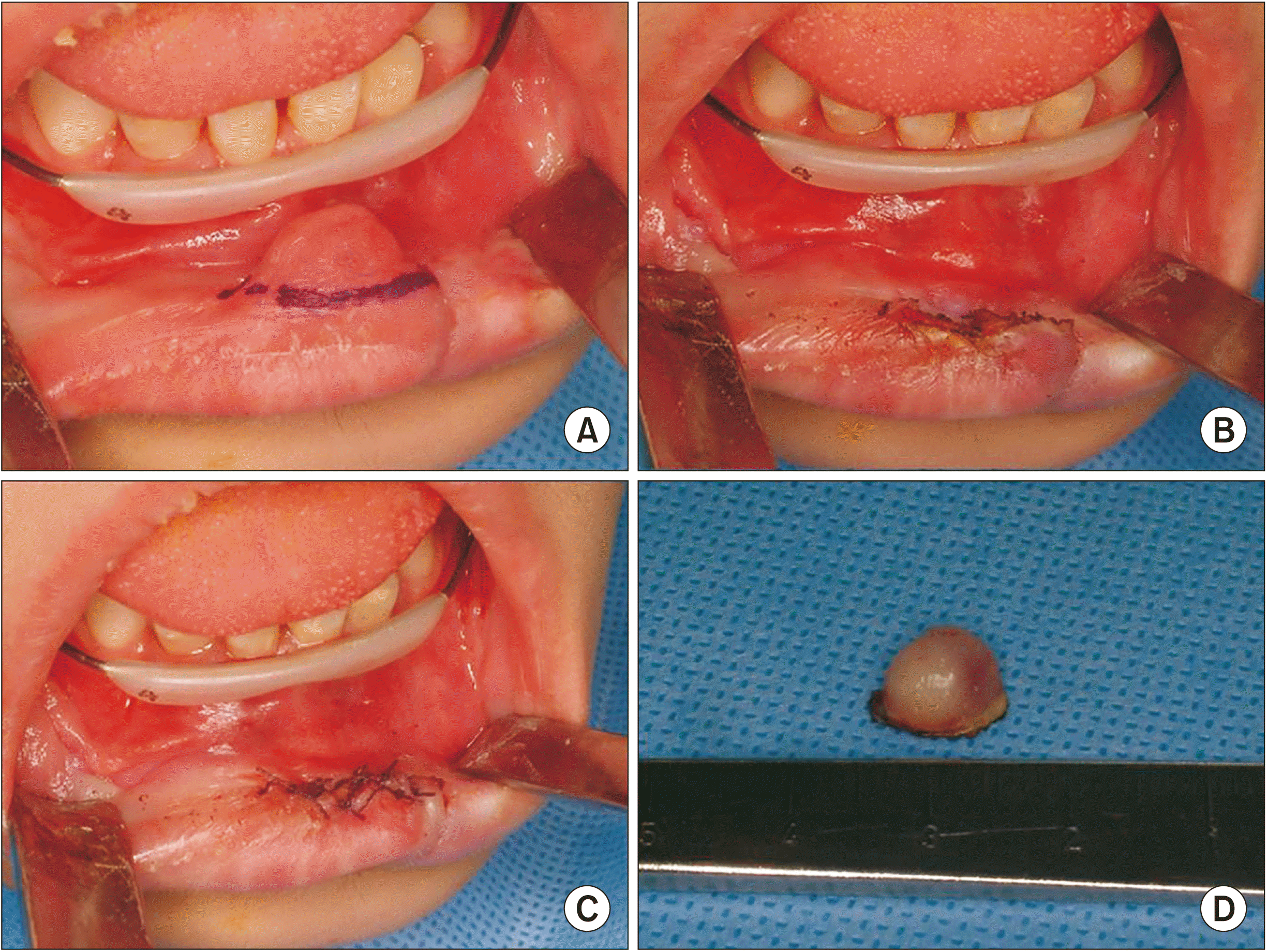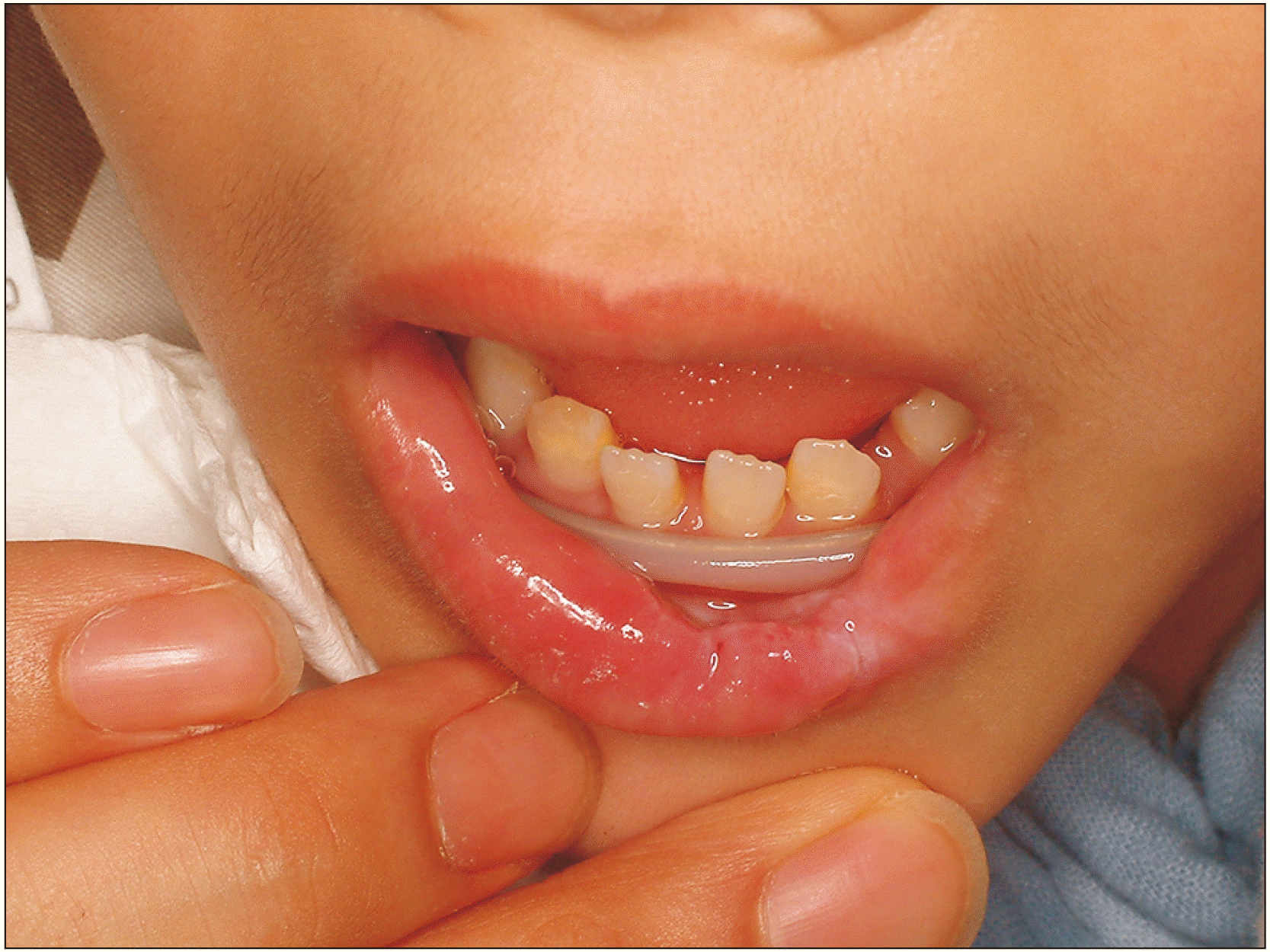Abstract
Lesch–Nyhan syndrome (LNS) is a rare X-linked recessive disorder caused by a mutation in the hypoxanthine phosphoribosyltransferase 1 (HPRT1) gene. This syndrome is characterized by excessive production of uric acid, mental retardation, self-mutilation, choreoathetosis, and spasticity. The most distinctive symptom is compulsive self-mutilation. For patients with LNS, different methods have been tried to reduce self-biting behaviors including restraints, behavioral treatment, medications, deep brain stimulation, tooth extraction and botulinum toxin A injection. In this report, we present a case of LNS undergoing cheiloplasty due to self-mutilation and tooth extraction of the left deciduous maxillary canine.
Lesch–Nyhan syndrome (LNS) is an X-linked recessive disorder caused by a mutation in the hypoxanthine phosphoribosyltransferase 1 (HPRT1) gene1-3. This enzyme plays a crucial role in the purine salvage pathway2. HPRT deficiency increases uric acid production resulting in neurological, renal and musculoskeletal manifestations4. This syndrome was first recognized by Michael Lesch and William Nyhan at Johns Hopkins Hospital in 19642. Most babies with LNS do not show signs at birth. Delayed motor development in sitting, crawling, and walking usually appears as the first signs of LNS by 3-6 months of age5,6. Common symptoms of LNS include dystonia, gout, mental retardation, self-mutilation, choreoathetosis, and spasticity2,4,6. The most distinctive symptom is compulsive self-mutilating behavior1. Patients with LNS feel pain and they do not want to self-injure or injure others6,7; however, they cannot stop this behavior by themselves6,7. The mechanism behind the self-mutilation behavior with LNS patients remains unclear2,8. Between ages 1 and 6 years, patients with LNS begin biting their lips, hands, and fingers3,7. As they get older, they develop different forms of self-aggression, including banging their heads, kicking, and scraping their arms7. Behavior modification, pharmacological treatments, intraoral devices, and surgical procedures have been used in patients with LNS to prevent self-injurious behavior9,10. Arm restraints can prevent fingers and arms from being bitten7. To decrease anxiety, self-injury and dystonia, many medications have been used either as monotherapies or in combination, including benzodiazepines, antidepressants, and antiepileptic drugs5-7. Allopurinol has been widely used to lower uric acid levels4. To protect the oral and perioral region, mouth guards and lip bumpers are frequently employed11. Extraction of all teeth has been recommended for severe cases.
In this report, we present the case of a LNS patient undergoing cheiloplasty of the lower lip due to self-mutilation and extraction of the left deciduous maxillary canine. To the best of our knowledge, this is the first case report of oral and maxillofacial surgery in LNS in Korea.
A 7-year-old boy with LNS and spastic dystonia was referred to Department of Oral and Maxillofacial Surgery at our hospital to treat self-mutilation of the lower lip. The medical history was as follows: When the patient was a 5 months old, his parents brought him to the department of pediatric neurology with a chief complaint of “he can’t hold his head up.” Laboratory tests revealed an increased serum uric acid level of 9.2 mg/dL. Based on genetic testing, HPRT1 deficiency confirmed the diagnosis of LNS. He started biting his left knuckle at five years of age, and began self-mutilating his lips and buccal mucosa at the age of six, causing lacerations and ulcerations of the oral and perioral soft tissue. The patient was administered allopurinol to treat uric acid overproduction. The patient has since continued to suffer from compulsive lip biting and buccal mucosa scratching, which left multiple scars on his lower lip.(Fig. 1)
Dental history was as follows: At the age of six, an alginate impression was taken to create a lip bumper under sedation with chloral hydrate syrup. The primary maxillary right canine and maxillary left central incisor were extracted at that time due to compulsive self-mutilation of the lower lip. After the lip bumper was placed, lip biting was significantly reduced. In addition to the oral device, multiple medications such as baclofen, clonzaepam, diazepam, and gabapentin were prescribed to manage LNS-associated anxiety, dystonia, and spasticity. However, the left maxillary deciduous canine erupted and the patient continued to bite his lower lip, causing deformation. A lower lip bumper was fabricated and fixed with metal bands to both first molars.
Under general anesthesia, bumpy and fibrotic scar tissue in the lower lip was removed with electrocautery.(Fig. 2) Primary closure was successfully achieved. The left deciduous canine was extracted with dental forceps. Good healing was observed one week after surgery.(Fig. 3)
Genomic DNA was extracted from peripheral blood leukocytes using a QIAmp DNA blood kit (Qiagen). Polymerase chain reaction (PCR) amplification was performed for all coding exons and their adjacent intron boundaries of the HPRT1 gene. PCR primers were designed using Primer3 in Table 1. PCR products were sequenced in both directions with a BigDye Terminatore V3.1 Cycle Sequencing Ready reaction kit (Applied Biosystems) and electrophoresis and analysis of the reaction mixtures were performed with the ABI3500xlDx Genetic analyzer (Applied Biosystems) and aligned to the GenBank sequence (accession No. NM_000194.3). Fig. 4 presents the electropherograms of the HPRT1 gene. The mutation nomenclature followed the recommendations of the Human Genome Variation Society (available at: https://varnomen.hgvs.org/; ver. 20.05).
For patients with LNS, different methods have been used to reduce self-mutilating behaviors2-5,12.(Table 2) Restraints, behavioral treatment, psychoactive medications, intrathecal baclofen pump and deep brain stimulation have produced variable results for managing self-mutilation in LNS3. Also, different trauma-preventing intraoral devices have been designed and fabricated to deflect tissues away from the teeth1, which promotes healing of injured tissues while permitting normal jaw movement. According to Arhakis et al.2, a maxillary appliance with an bite raising occlusal plate helped a patient with LNS to stop biting their lips and tongue. Traumatic lesions had resolved completely within 4 weeks post-insertion1.
Cauwels and Martens4 demonstrated that positive behavioral modification could be achieved by a combination of a mouth guard in the upper jaw and a lip-bumper in the lower jaw. If self-mutilating behavior is not responsive to behavioral modification, oral devices and/or medications, patients may require extraction of the primary teeth. In this patient, a lower lip bumper was fabricated at the age of six at the department of pediatric dentistry. The lower lip bumper reduced but did not eliminate biting of the lower lip. The four upper anterior teeth were extracted serially when they erupted. A recent lower lip injury and scar were created after eruption left deciduous maxillary canine tooth. During lower lip revision, #63 was extracted.
Since botulinum toxin (BTX) has been used for pathologies manifested by abnormal, excessive, or inappropriate muscle contraction, BTX has also been applied to patients with LNS7. According to Gilbert et al.3, BTX injection into the bilateral masseter and temporalis muscles demonstrated significant improvement in speech and reductions in self-mutilating behavior. In addition to masticatory muscles, Garcia-Romero et al.7 injected BTX into the biceps brachii to reduce self-mutilation in patients with LNS. It was a useful and safe method to reduce self-biting behavior and prevent biting their hands or arms or using their arms7. The same authors7 recommended high doses of BTX on a regular basis to obtain good results. According to Gutierrez et al.12, small doses of BTX injection in the facial muscles including zygomatic, lip orbicularis and lip mentalis muscles are useful to prevent self-mutilation. In the patient in the current case, BTX injection was delayed. Injection is planned for when lip-biting is aggravated.
The underlying cause of LNS needs to be better understood in order to provide more effective treatment1. Different therapeutic modalities are necessary to prevent self-mutilating behavior. In oral and maxillofacial surgery, surgeons should consider extraction of permanent teeth when patients persist with self-mutilation. In addition, BTX injections in masticatory and facial muscles can be helpful to reduce self-biting behavior and control dystonia. LNS patients with lip deformities due to persistent lip biting may require scar revision.
Notes
Authors’ Contributions
H.I.P. wrote the manuscript. K.M.A. designed the report and helped to draft the manuscript. G.H.K. performed the genetic analysis. All authors read and approved the final manuscript.
References
1. Bell S, Kolobova I, Crapper L, Ernst C. 2016; Lesch-Nyhan syndrome: models, theories, and therapies. Mol Syndromol. 7:302–11. https://doi.org/10.1159/000449296. DOI: 10.1159/000449296. PMID: 27920633. PMCID: PMC5131334.

2. Arhakis A, Topouzelis N, Kotsiomiti E, Kotsanos N. 2010; Effective treatment of self-injurious oral trauma in Lesch-Nyhan syndrome: a case report. Dent Traumatol. 26:496–500. https://doi.org/10.1111/j.1600-9657.2010.00930.x. DOI: 10.1111/j.1600-9657.2010.00930.x. PMID: 21078074.

3. Gilbert C, Sauer M, Cheng J. 2021; Reduction of self-mutilating behavior and improved oromotor function in a patient with Lesch-Nyhan syndrome following botulinum toxin injection: a case report. J Pediatr Rehabil Med. 14:133–6. https://doi.org/10.3233/prm-200729. DOI: 10.3233/PRM-200729. PMID: 33720862.

4. Cauwels RG, Martens LC. 2005; Self-mutilation behaviour in Lesch-Nyhan syndrome. J Oral Pathol Med. 34:573–5. https://doi.org/10.1111/j.1600-0714.2005.00330.x. DOI: 10.1111/j.1600-0714.2005.00330.x. PMID: 16138897.

5. Dabrowski E, Smathers SA, Ralstrom CS, Nigro MA, Leleszi JP. 2005; Botulinum toxin as a novel treatment for self-mutilation in Lesch-Nyhan syndrome. Dev Med Child Neurol. 47:636–9. https://doi.org/10.1111/j.1469-8749.2005.tb01218.x. DOI: 10.1111/j.1469-8749.2005.tb01218.x. PMID: 16138673.

6. Harris JC. 2018; Lesch-Nyhan syndrome and its variants: examining the behavioral and neurocognitive phenotype. Curr Opin Psychiatry. 31:96–102. https://doi.org/10.1097/yco.0000000000000388. DOI: 10.1097/YCO.0000000000000388. PMID: 29227296.

7. Garcia-Romero MDM, Torres RJ, Garcia-Puig J, Pascual-Pascual SI. 2022; Safety and efficacy of botulinum toxin in the treatment of self-biting behavior in Lesch-Nyhan disease. Pediatr Neurol. 127:6–10. https://doi.org/10.1016/j.pediatrneurol.2021.10.018. DOI: 10.1016/j.pediatrneurol.2021.10.018. PMID: 34891105.

8. Limeres J, Feijoo JF, Baluja F, Seoane JM, Diniz M, Diz P. 2013; Oral self-injury: an update. Dent Traumatol. 29:8–14. https://doi.org/10.1111/j.1600-9657.2012.01121.x. DOI: 10.1111/j.1600-9657.2012.01121.x. PMID: 22340154.

9. Shapira J, Birenboim R, Shoshani M, Abdel-Kader A, Behar O, Moskovitz M, et al. 2016; Overcoming the oral aspects of -self-mutilation: description of a method. Spec Care Dentist. 36:282–7. https://doi.org/10.1111/scd.12181. DOI: 10.1111/scd.12181. PMID: 27105292.

10. Ragazzini G, Delucchi A, Calcagno E, Servetto R, Denotti G. 2014; A modified intraoral resin mouthguard to prevent self-mutilations in lesch-nyhan patients. Int J Dent. 2014:396830. https://doi.org/10.1155/2014/396830. DOI: 10.1155/2014/396830. PMID: 25101126. PMCID: PMC4102014.

11. Jathar P, Panse AM, Jathar M, Gawali PN. 2016; Lesch-Nyhan syndrome: disorder of self-mutilating behavior. Int J Clin Pediatr Dent. 9:139–42. https://doi.org/10.5005/jp-journals-10005-1350. DOI: 10.5005/jp-journals-10005-1350. PMID: 27365935. PMCID: PMC4921883.

12. Gutierrez C, Pellene A, Micheli F. 2008; Botulinum toxin: treatment of self-mutilation in patients with Lesch-Nyhan syndrome. Clin Neuropharmacol. 31:180–3. https://doi.org/10.1097/wnf.0b013e31814a62cc. DOI: 10.1097/WNF.0b013e31814a62cc. PMID: 18520986.

Fig. 1
Scar tissue removal. A. Marking of the scar tissue. B. Excision via electrocautery. C. Primary closure with absorbable suture. D. Excised lip scar.

Fig. 4
Hypoxanthine phosphoribosyltransferase 1 (HPRT1) gene mutation analysis. Blue arrow indicates the mutation of G to A.

Table 1
Sequences of primers using polymerase chain reaction reaction
Table 2
Summary of dental treatment in Lesch–Nyhan syndrome
| Study | Age (yr)/sex | Treatment | Treatment effect |
|---|---|---|---|
| Dabrowski et al.5 (2005) | 10/M | BTX-A injection in both masseter muscles, a total of 40 units, every 12 weeks |
• ↑ Speech articulation • No impact on eating or swallowing |
| Cauwels and Martens4 (2005) | 5/M | Combination of a mouthguard in the upper jaw and a lip-bumper in the lower jaw | • Positive behavioral modification |
| Gutierrez et al.12 (2008) | 30/M | BTX-A injection in both zygomatic muscles 12.5 IU each, six sites in the lower part of the lip orbicularis muscle of 2.5 IU each, and three injections in the levator labii inferioris of 5 IU each, every 3 months |
• ↓ Lip biting and self-mutilating behavior • No side effects |
| Arhakis et al.2 (2010) | 14/M | Maxillary acrylic appliance with a posterior occlusal bite plate | • During the 3-year follow up, self-injury behavior disappeared |
| Gilbert et al.3 (2021) | 13/M | BoNT injection in both masseter muscles, to a total of 50 units, every 4-6 months |
• ↑ Speech articulation • ↓ Self-mutilating behavior • ↑ Feeding |




 PDF
PDF Citation
Citation Print
Print





 XML Download
XML Download